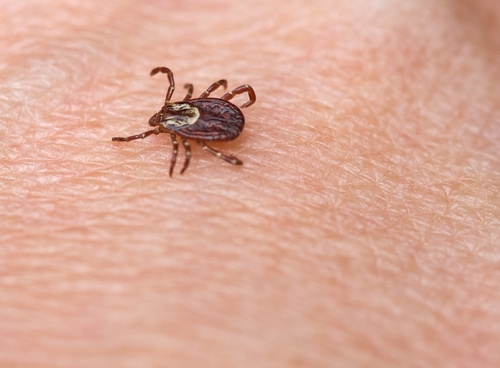If you’ve ever ventured into the great outdoors, you know that ticks can be quite unwelcome companions. These tiny parasitic arachnids might be small, but the problems they can cause are anything but! Ticks can carry dangerous diseases such as Lyme disease, so being able to fend them off is necessary for those who live in places where ticks tend to thrive.
But fear not, for Mother Nature herself might just have a solution to our tick troubles. In this article, we’re diving headfirst into the world of plants that repel ticks. That’s right, there are certain plants out there that have the incredible power to keep these pesky critters at bay.

1. Rosemary

Rosemary is a fantastic tick repellent, but it is also a beneficial plant to have in your garden if you have marigolds, sage, or marjoram.
©Maren Winter/Shutterstock.com
Rosemary is an aromatic herb recognized for its distinctive fragrance and diverse applications. Native to the Mediterranean region, rosemary is an evergreen shrub characterized by its needle-like leaves and small blue flowers. Beyond its culinary uses, rosemary is gaining attention for its natural ability to repel ticks, those small, blood-sucking pests that can transmit diseases.
The tick-repelling properties of rosemary stem from the essential oils found within its leaves. These oils contain compounds like cineol, camphor, and terpene, which emit a potent scent. This scent acts as a natural deterrent for ticks and other insects. When the aroma of rosemary releases into the environment, it creates an atmosphere that ticks find disagreeable, prompting them to avoid the area.
The cause behind rosemary’s tick-repelling effect lies in its impact on tick sensory perception. Ticks heavily rely on their senses, particularly their keen sense of smell, to locate suitable hosts for feeding. However, the strong fragrance of rosemary interferes with this process. The overwhelming aroma overwhelms the ticks’ olfactory receptors, making it challenging for them to pinpoint potential hosts.
In practical terms, rosemary’s tick-repelling benefits can be harnessed in various ways. Planting rosemary in outdoor spaces can create a natural barrier against ticks. Also, you can make your tick-repellent spray by steeping rosemary leaves in water and applying the infused liquid to clothes and surroundings. Crushing fresh rosemary leaves and applying them to the skin before venturing outdoors can also help deter ticks. Rosemary essential oil can be used in diffusers or mixed with carrier oils to create an effective tick-repellent.
2. Wormwood

Wormwood is a great herb to use for helping digestion and even potentially reducing pain caused by arthritis.
©iStock.com/Larysa Lyundovska
Wormwood is a perennial herb known for its distinctive aroma and potential tick-repelling properties. Originating from Europe and parts of Asia, wormwood has long been utilized for its various uses, including medicinal and culinary applications. Beyond its traditional uses, wormwood has gained attention for its ability to repel ticks.
The tick-repelling characteristics of wormwood are attributed to the presence of certain compounds in its leaves and stems, including thujone and other volatile oils. These compounds release a strong scent that acts as a natural deterrent for ticks and other pests. When the scent is released into the environment, it creates an unwelcoming atmosphere for ticks, discouraging them from approaching.
Wormwood’s scent is what repels ticks. When searching for hosts to feed on, ticks depend significantly on their sense of smell. However, the strong aroma of wormwood prevents this from happening. Ticks have trouble identifying possible hosts in the presence of such a powerful odor.
Practical applications of wormwood for tick prevention are diverse. Planting wormwood in outdoor spaces, particularly near areas prone to tick activity, can establish a natural barrier against these pests. For personal use, wormwood leaves can be crushed and applied to clothing or skin before venturing outdoors. Just as well, wormwood essential oil can be diluted and used as a spray or applied to clothing to enhance tick protection.
3. Garlic

Garlic is a great plant for deterring ticks, as well as rabbits and deer.
©Liubomyr Tryhubyshyn/Shutterstock.com
Garlic is a widely-used culinary ingredient that possesses more than just its distinctive flavor. Originating from Asia, garlic has been renowned for its potential to repel ticks. This bulbous plant’s repellent properties stem from its sulfur-containing compounds, such as allicin, which give garlic its characteristic odor.
Garlic’s tick-repelling effect relies on its strong aroma. (You’re probably seeing a pattern in how plants deter ticks!) When garlic is ingested or applied, its pungent scent is exuded through the skin’s pores. This scent acts as a natural deterrent, creating an environment that ticks find unappealing. This prompts ticks to avoid areas where the scent is present.
Garlic’s ability to deter ticks stems from its influence on the insects’ sense of smell. The pungent smell of garlic interferes with it. The overwhelming aroma makes it harder for ticks to identify their victims by driving them away and confusing them.
Incorporating garlic into tick prevention strategies can take various forms. Consuming garlic regularly may result in the release of the odor through sweat, potentially deterring ticks. Also, creating a homemade garlic spray by crushing garlic cloves and mixing them with water can be used to treat clothing, gear, or the environment, enhancing tick protection.
4. Lavender

Lavender is a very visually stunning plant that could complement any garden that needs a pop of color.
©ESstock/Shutterstock.com
Lavender is a fragrant herb widely recognized for its soothing scent and diverse uses. Native to the Mediterranean region, lavender has transcended its aromatic appeal to offer potential benefits as a natural tick repellent. Its repelling properties are attributed to the essential oils present in its flowers and leaves.
Lavender’s ability to repel ticks is rooted in its distinctive aroma. The essential oils found in lavender, including compounds like linalool and linalyl acetate, release a powerful scent that acts as a natural deterrent for ticks and other insects. When the aroma permeates the air, it creates an environment that ticks find uninviting, prompting them to stay away.
The sensory experience of ticks is at the heart of lavender’s ability to deter them. When searching for a host to feed on, ticks depend significantly on their sense of smell. However, the strong lavender scent prevents this from happening. Ticks have a hard time locating appropriate hosts because of the overwhelming aroma.
Lavender can be used in various ways for tick prevention. Planting lavender in outdoor areas can establish a natural barrier against ticks. Making homemade tick-repellent sprays by infusing water with crushed lavender flowers or essential oil can enhance tick protection for clothing and surroundings. Additionally, lavender-scented products, such as candles or oils, can be used to create a tick-repelling ambiance.
5. Mint

While mint’s pungent scent may be unpleasant to tick, it’s quite pleasant to humans and can act as a natural outdoor fragrance.
©Olesya Myzzz/Shutterstock.com
Mint is a well-known herb with a refreshing aroma. Originating from Europe and Asia, mint has garnered attention for its potential to repel ticks. The tick-repelling qualities of the mint are attributed to its essential oils, such as menthol and pulegone, which emit a strong fragrance.
Mint’s tick-repelling effect hinges on its powerful scent. The essential oils contained in mint plants release an aroma that acts as a natural deterrent for ticks and other insects. This scent creates an environment that ticks find disagreeable, compelling them to avoid the area.
The underlying mechanism of mint’s tick-repelling ability revolves around tick sensory perception. Ticks rely on their senses, particularly their keen sense of smell, to locate hosts for blood-feeding. Yet, the potent fragrance of mint interferes with this process. The overwhelming scent disrupts ticks’ ability to accurately locate potential hosts.
Cultivating mint plants in outdoor spaces can establish a natural barrier against ticks. Creating homemade tick-repellent solutions by steeping mint leaves in water and using the resulting liquid as a spray for clothing and surroundings can enhance tick protection. Moreover, mint-infused oils or products can contribute to creating a tick-repelling ambiance.
Other Ways to Repel Ticks
In addition to planting tick-repelling plants, there are other effective methods to repel ticks and reduce your risk of encountering these pests.
1. Clothing Choices Matter
Ticks often lurk in tall grasses and wooded areas. Wearing long-sleeved shirts, long pants, and closed-toe shoes can act as a physical barrier, making it harder for ticks to attach to your skin. Tuck your pants into your socks and opt for light-colored clothing, which makes ticks more visible and easier to spot.
2. Tick-Repellent Clothing and Gear
Consider clothing treated with permethrin, a synthetic insecticide that repels and kills ticks on contact. Permethrin-treated clothing can remain effective even after several washes. Additionally, use gear like hats and socks treated with permethrin to create a tick-repellent barrier.
3. Insect Repellents
Use Environmental Protection Agency (EPA)-registered insect repellents containing active ingredients like DEET, picaridin, or IR3535. These repellents are proven to effectively deter ticks. Apply the repellent evenly on exposed skin and clothing, following the instructions on the product label. Remember to avoid applying repellents to hands, eyes, and mouth.
4. Regular Body Checks
Perform thorough body checks after spending time outdoors, especially in tick-prone areas. Ticks are small and can be challenging to detect, so pay attention to hidden areas like the groin, armpits, scalp, and behind the ears. Swiftly removing any attached ticks can help prevent disease transmission.
5. Stay in the Center When Hiking
When hiking or walking in areas with tall grass or woods, stick to the center of the trails. Ticks are more likely to be in vegetation along the edges. Avoid brushing against vegetation, as this can dislodge ticks onto your clothing.
6. Maintain Your Yard
Ticks often thrive in overgrown and cluttered yards. Regularly mow your lawn and trim shrubs to reduce tick habitats. Clear leaf litter, woodpiles, and other debris that may attract these pests. Creating a clean and well-maintained environment can discourage ticks from establishing themselves.
7. Shower After Outdoor Activities

It’s important to shower after you’ve been in an area where you could have come into contact with ticks.
©Maridav/Shutterstock.com
Taking a quick (but thorough) shower within one or two hours of returning home can help wash away any ticks that are not attached. A shower can also provide an opportunity to thoroughly inspect your body for any signs of attached ticks. Use a washcloth to carefully scan for any hidden ticks that might have latched on.
8. Landscaping Modifications
Consider making your outdoor space less appealing to ticks. Create a barrier between your yard and wooded areas by using gravel or wood chips. Ticks are less likely to cross these dry and less vegetated zones.
9. Always Check Your Gear After a Hike
Ticks can hitch a ride indoors on clothing, gear, and even pets. Examine your belongings before bringing them inside. Tumble-dry clothes on high heat for at least 10 minutes to kill any ticks that might be present.
By incorporating these preventative measures, you can significantly reduce your risk of tick bites and the potential health complications they can bring. Stay vigilant, stay informed, and enjoy the outdoors safely!
Summary of Plants That Repel Pesky Ticks
| # | Plant | Sunlight Needs |
|---|---|---|
| 1 | Rosemary | Full sun |
| 2 | Wormwood | Full sun |
| 3 | Garlic | Full sun |
| 4 | Lavender | Full sun |
| 5 | Mint | Full sun or partial shade |
Thank you for reading! Have some feedback for us? Contact the AZ Animals editorial team.








